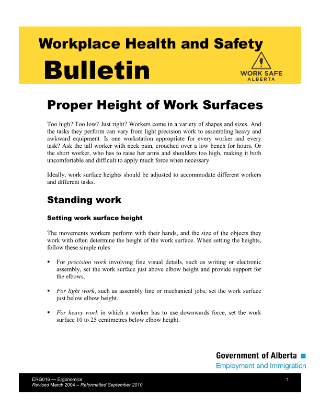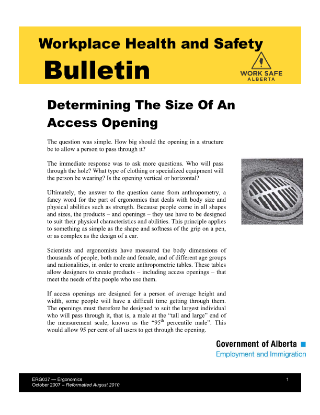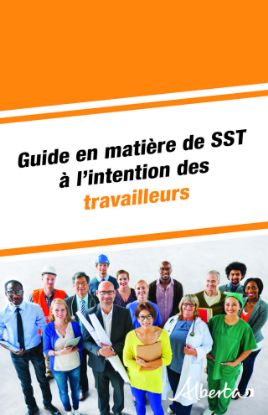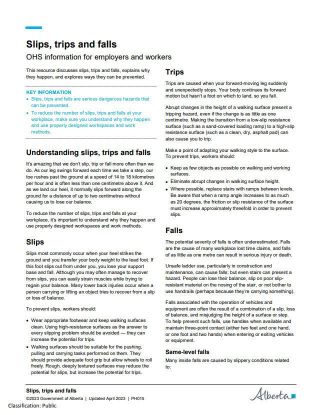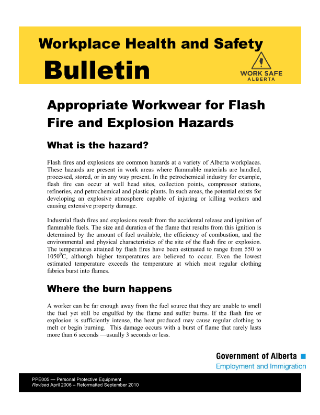Bulletins
Short resources that offer focused information on specific topics.
Working in restricted or confined spaces
CS001
This resource provides information about Alberta's legislated requirements for working in restricted and confined spaces.
UPDATED: April 2025
UPDATED: April 2025
Anti-Fatigue Matting
ERG005
Describes how anti-fatigue matting works and factors to consider when purchasing.
PUBLISHED: August 2010
PUBLISHED: August 2010
How much can I lift?
ERG013
Discusses the hazards of manual lifting, health effects and suggested controls.
PUBLISHED: February 2017
PUBLISHED: February 2017
Sitting and Preventing Back Pain
ERG014
Suggestions to help reduce back pain for those who spend long hours in a seated position.
PUBLISHED: August 2010
PUBLISHED: August 2010
Fatigue, Extended Work Hours and Workplace Safety
ERG015
Discusses the hazards of fatigue and extended work hours, health effects and suggested controls.
PUBLISHED: February 2017
PUBLISHED: February 2017
Proper Height of Work Surfaces
ERG016
Tips on how to adjust work surfaces to the appropriate height to avoid overuse or stress injuries.
PUBLISHED: March 2004
PUBLISHED: March 2004
Selecting Hand Tools
ERG023
Explains the causes of contact stress, health risks and suggested controls.
PUBLISHED: September 2010
PUBLISHED: September 2010
Ergonomics in the workplace: Vibration
ERG026
This resource provides information about the hazards associated with hand/arm and whole body vibration, OHS requirements related to workplace vibration, and best-practice controls.
UPDATED: February 2024
UPDATED: February 2024
Good Product Design: Avoiding the Average
ERG030
How designers design for the average person, which doesn't always work.
PUBLISHED: May 2003
PUBLISHED: May 2003
Push It or Pull It?
ERG033
Addresses safety concerns associated with wheeled equipment, such as carts, and suggests preventative controls.
PUBLISHED: August 2004
PUBLISHED: August 2004
Determining the Size of an Access Opening
ERG037
Considerations when determining the size of an access opening.
PUBLISHED: October 2007
PUBLISHED: October 2007
Workplace first aid approvals
FA017
This bulletin explains how training agencies can apply for approval to teach workplace first aid in Alberta.
UPDATED: August 2023
UPDATED: August 2023
Managing Hot Work
FEX001
***This resource is current to May 2007.
For information on the current OHS requirements, visit OHS website.***
A description of hot work as a fire and explosion hazard and direction for performing hot work under the OHS Code.
PUBLISHED: May 2007
For information on the current OHS requirements, visit OHS website.***
A description of hot work as a fire and explosion hazard and direction for performing hot work under the OHS Code.
PUBLISHED: May 2007
Handling and Storage of Flammable Materials at the Work Site
FEX002
***This resource is current to July 2009.
For information on the latest OHS requirements, visit OHS website.***
A complete resource on flammable materials including definitions, associated hazards, worker training, storage, and incompatible substances.
PUBLISHED: July 2009
For information on the latest OHS requirements, visit OHS website.***
A complete resource on flammable materials including definitions, associated hazards, worker training, storage, and incompatible substances.
PUBLISHED: July 2009
Controlling the Explosion Hazard in Vessels, Tanks and Piping Systems
FEX004
***This resource is current to August 2010.
For information on the latest OHS requirements, visit OHS website.***
Outlines safe work procedures for preparing hydrocarbon-containing vessels, tanks or piping systems for hot work, confined space entry or hydrocarbon removal.
PUBLISHED: August 2010
For information on the latest OHS requirements, visit OHS website.***
Outlines safe work procedures for preparing hydrocarbon-containing vessels, tanks or piping systems for hot work, confined space entry or hydrocarbon removal.
PUBLISHED: August 2010
Wildfire smoke
FI007
This publication discusses wildfire smoke as a workplace hazard. Includes information on potential health effects, risks and controls.
UPDATED: August 2024
UPDATED: August 2024
Working in smoky environments
FI008
This bulletin provides health and safety information regarding exposure risks and hazards when working in smoky environments.
UPDATED: May 2023
UPDATED: May 2023
West Nile Virus and Workers
GH013
Explains what West Nile Virus is and how it affects the workplace, suggestions for hazard assessment and controls.
UPDATED: August 2009
UPDATED: August 2009
Indoor air quality
GH014
This bulletin explains why indoor air quality is important, and talks about some of the factors that affect indoor air quality. It also introduces some occupational health and safety requirements that may apply to indoor air quality concerns.
UPDATED: December 2022
UPDATED: December 2022
Securing Pipe and Other Cargo on Vehicles
GS001
***This resource is current to October 2009.
For information on the current OHS requirements, visit OHS website.***
Information about securing pipe and other cargo, including employer and worker responsibilities, and recommended practices.
PUBLISHED: October 2009
For information on the current OHS requirements, visit OHS website.***
Information about securing pipe and other cargo, including employer and worker responsibilities, and recommended practices.
PUBLISHED: October 2009
Servicing Tires Safely
GS003
***This resource is current to August 2004.
For information on the latest OHS requirements, visit OHS website.***
Addresses tire servicing safety requirements under the OHS Code including worker competency, split-rim or locking ring wheel assemblies and large vehicle assemblies.
PUBLISHED: August 2004
For information on the latest OHS requirements, visit OHS website.***
Addresses tire servicing safety requirements under the OHS Code including worker competency, split-rim or locking ring wheel assemblies and large vehicle assemblies.
PUBLISHED: August 2004
Guarding of Commercial Dough and Food Preparation Mixers
GS004
Addresses guarding of commercial dough and food preparation mixers to protect workers.
PUBLISHED: March 2005
PUBLISHED: March 2005
Manually Energizing Power Systems after an Unplanned Outage: An Alberta Electric Utility Best Practice
GS008
***This resource is current to October 2010.
For information on the current OHS requirements, visit OHS website.***
Lists the standard minimum steps an electric utility must include for manually energizing a power system after an unplanned outage.
UPDATED: October 2010
For information on the current OHS requirements, visit OHS website.***
Lists the standard minimum steps an electric utility must include for manually energizing a power system after an unplanned outage.
UPDATED: October 2010
Tips on selecting an OHS consultant
GS009
Tip sheet for employers when considering hiring an occupational health and safety consultant.
UPDATED: October 2024
UPDATED: October 2024
Fall protection plan
GS010
This resource provides information about occupational health and safety fall protection plans and their legal requirements.
UPDATED: February 2023
UPDATED: February 2023
Snow and Ice on Commercial Vehicles
GS011
***This resource is current to December 2016.
For information on the latest OHS requirements, visit OHS website.***
Addresses the danger of snow and ice coming off commercial vehicles while in motion and the hazards associated with clearing snow and ice buildup.
PUBLISHED: December 2016
For information on the latest OHS requirements, visit OHS website.***
Addresses the danger of snow and ice coming off commercial vehicles while in motion and the hazards associated with clearing snow and ice buildup.
PUBLISHED: December 2016
Powered Mobile Equipment Rollover Safety Precautions
GS012
***This resource is current to August 2017.
For information on the latest OHS requirements, visit OHS website.***
Lists factors that contribute to mobile equipment rollover and recommended safety precautions.
PUBLISHED: August 2017
For information on the latest OHS requirements, visit OHS website.***
Lists factors that contribute to mobile equipment rollover and recommended safety precautions.
PUBLISHED: August 2017
Domestic workers
LI069
Addresses some of the hazards associated with domestic work and the obligations of employers and workers under Alberta OHS legislation.
UPDATED: April 2022
UPDATED: April 2022
Noise at the work site
HS003
Discusses noise as a common workplace hazard, including information about associated health effects and exposure limits, implementing a noise management program, audiometric testing, and educating workers.
UPDATED: October 2024
UPDATED: October 2024
Guide en matière de SST à l’intention des travailleurs
LI008FR
(ENGLISH TITLE: Guide to OHS: Workers)
Présente la législation en matière de santé et de sécurité au travail (SST) en mettant l’accent sur ce que les travailleurs doivent faire pour se conformer à la loi.
MISE À JOUR : février 2023
Présente la législation en matière de santé et de sécurité au travail (SST) en mettant l’accent sur ce que les travailleurs doivent faire pour se conformer à la loi.
MISE À JOUR : février 2023
Legal terms 101: “reasonably practicable”
LGT001
Provides an overview of the terms "reasonably practicable" and "due diligence" in relation to Alberta's OHS legislation.
UPDATED: May 2022
UPDATED: May 2022
Incident reporting and investigation
LI016
This bulletin introduces requirements to report injuries, illnesses, incidents and potentially serious incidents to Alberta Occupational Health and Safety (OHS). It also addresses employer and OHS officer investigations.
UPDATED: April 2025
UPDATED: April 2025
Prime contractor role and duties
LI018
Overview of prime contractor role and obligations.
UPDATED: June 2024
UPDATED: June 2024
Are students and volunteers workers?
LI022
Explains when students and volunteers are considered workers under the OHS Act.
UPDATED: April 2022
UPDATED: April 2022
Health and safety programs
LI042
Explains the legal requirement to establish and implement a health and safety program. Gives an overview of what a health and safety program can include.
UPDATED: January 2023
UPDATED: January 2023
Violence and harassment in the workplace
LI045
Explains key legal requirements for preventing workplace violence and harassment. Focuses on the definitions of violence and harassment in the OHS Act, and requirements in Part 27 of the OHS Code.
UPDATED: April 2025
UPDATED: April 2025
Role and duties of Alberta OHS officers
LI046
Explains the role of Alberta OHS officers in monitoring compliance with occupational health and safety legislation. Includes an overview of inspection and investigation authorities, and enforcement tools.
UPDATED: December 2021
UPDATED: December 2021
Hazardous footwear
LI050
Explains requirements regarding employer-imposed footwear under the OHS Code.
UPDATED: July 2022
UPDATED: July 2022
Occupational health and safety and the internal responsibility system
LI051
Explains how the internal responsibility system works as the basis of Alberta's OHS legislation.
UPDATED: April 2022
UPDATED: April 2022
Report on compliance
LI052
Explains how employers complete a report on compliance, if an OHS officer has required them to do so.
UPDATED: February 2022
UPDATED: February 2022
Occupational health and safety and the non-profit sector
LI053
This resource provides information for non-profit organizations regarding their responsibilities under Alberta’s OHS legislation.
UPDATED: August 2022
UPDATED: August 2022
Participation in health and safety for small business owners and workers
LI055
Introduces requirements for worker participation in health and safety that apply to small businesses (fewer than 20 workers).
UPDATED: March 2025
UPDATED: March 2025
Health and safety committees and representatives
LI060
Information about Alberta workplace health and safety committee and representative requirements.
UPDATED: July 2025
UPDATED: July 2025
Guideline for the Use of Contact Lenses in Industry
MG001
***This resource is current to August 2008.
For information on the latest OHS requirements, visit OHS website.***
Discusses the pros and cons of wearing contact lenses in industry.
PUBLISHED: August 2008
For information on the latest OHS requirements, visit OHS website.***
Discusses the pros and cons of wearing contact lenses in industry.
PUBLISHED: August 2008
Let’s Back Up a Bit: Some Truths About Back Belts
PH003
Addresses health and safety concerns and refutes claims about the use of back belts.
PUBLISHED: August 2010
PUBLISHED: August 2010
Slips, trips and falls
PH015
Discusses slips, trips and falls, why they happen and how to prevent them.
UPDATED: April 2023
UPDATED: April 2023
Respiratory Protective Equipment: An Employer’s Guide
PPE001
***This resource is current to March 2020.
For information on the latest OHS requirements, visit OHS website.***
This guide provides information on when to use RPE, what types of RPE there are and the steps to determine if RPE is necessary.
UPDATED: March 2020
For information on the latest OHS requirements, visit OHS website.***
This guide provides information on when to use RPE, what types of RPE there are and the steps to determine if RPE is necessary.
UPDATED: March 2020
Respiratory protective equipment: Code of practice development
PPE004
***This resource is current to March 2020.
For information on the latest OHS requirements, visit OHS website.***
Guidelines on developing a code of practice (COP) describing the selection, maintenance and use of respiratory protective equipment (RPE) be developed whenever respirators are used at the work site to meet legislated requirements.
UPDATED: March 2020
For information on the latest OHS requirements, visit OHS website.***
Guidelines on developing a code of practice (COP) describing the selection, maintenance and use of respiratory protective equipment (RPE) be developed whenever respirators are used at the work site to meet legislated requirements.
UPDATED: March 2020
Appropriate Workwear for Flash Fire and Explosion Hazards
PPE005
***This resource is current to April 2006.
For information on the latest OHS requirements, visit OHS website.***
Discusses elements to consider when purchasing fire retardent clothing.
PUBLISHED: April 2006
For information on the latest OHS requirements, visit OHS website.***
Discusses elements to consider when purchasing fire retardent clothing.
PUBLISHED: April 2006
Eye Protection at the Work Site
PPE007
***This resource is current to June 2012.
For information on the latest OHS requirements, visit OHS website.***
Discusses hazards that could cause eye damage and lists controls to protect the eyes.
PUBLISHED: June 2012
For information on the latest OHS requirements, visit OHS website.***
Discusses hazards that could cause eye damage and lists controls to protect the eyes.
PUBLISHED: June 2012





